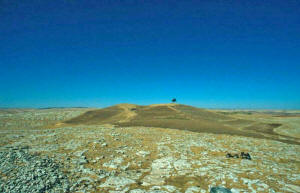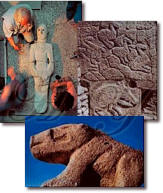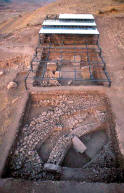|

by A. Cihat Kürkçüoğlu
Harran University, Faculty of Science and Letters
from
Basin Yayin ve Enformasyon Genel Mudurlugu Website
Archeological discoveries in Urfa continue to yield exciting results
with each passing day. Scientists are rushing to see the remains of
an 11,500-year-old temple discovered in Göbeklitepe. Furthermore, a
13,500-year-old statue, the worlds oldest, discovered during an
excavation in Balıklıgöl has astonished archeologists from all over
the world. Assistant Professor A. Cihat Kürkçüoğlu of Harran
University claims that the history of civilization began in Urfa.
Exploratory excavations conducted in Çayönü, Diyarbakır have
revealed remains of houses which date back 10,500-11,000 years. Even
more surprising have been the results of excavations conducted in
the Nevale Çori region, which indicate that the people of Nevale
Çori settled and lived in houses 500 years before the people of
Çayönü. They are also known to have been the first people to engage
in agriculture.
First Temple
During exploratory excavations conducted in Göbeklitepe in 1995, the
remains of a temple were discovered. Quite similar to those
discovered in Nevale Çori, these remnants are considered to be one
of the first examples of architectural structure.
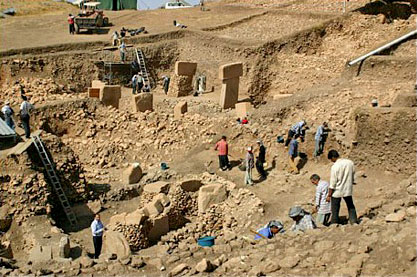
Artifacts discovered in the center of the city of Urfa indicate that
settlement in the region began even earlier. Bahattin Çelik, a
research assistant in the Department of Archeology and Art History
at Hacettepe University, recently has said that arrows and
spearheads made of flint, cutting tools and interior furnishings
were discovered in the Balıklıgöl region.
Laboratory analysis
carried out in Germany last year proved that these finds are at
least 11,500 years old.
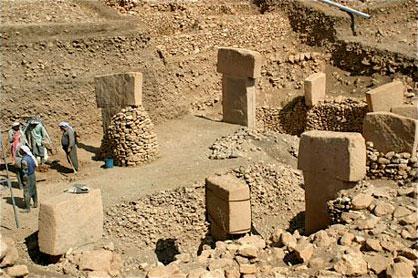
Kürkçüoğlu described the results of the excavations as a marvelous
discovery and said:
With this discovery, the history we have
obtained up until now about the Neolithic age has been brought back
2,000 years. We now know that our fellow human beings built the
first houses in history in the fertile area near Balıklıgöl 13,500
years ago.
|

The two meter high Balıklıgöl Statue is the oldest statue
discovered until now.
|
Worlds Oldest Statue
A two-meter high statue of a male (click right image) was discovered in Balıklıgöl in
1993. The limestone statue the eyes of which are carved out of
obsidian depicts a man seizing his genital organ with both hands. It
was named the Balıklıgöl Statue and is on display in Urfa Museum.
Kürkçüoğlu provided the following details about the statue:
Scientists have confirmed that the Balıklıgöl Statue is the
oldest statue ever to be discovered until now. The statue, which was
in a Neolithic temple, represents the God of Eroticism or the God
of Reproduction.
Therefore, we are certain that the Balıklıgöl
settlement is 2,000 years older than the Nevale Çori and Göbeklitepe
settlements. Each exploratory excavation and the finds discovered in
Urfa add to our knowledge of the Neolithic age.
Transition to Sedentary Life and Agriculture
During excavations conducted by Kürkçüoğlu, Abdüsselam Uluçam,
Bahattin Çelik and Fatih Uluçam on behalf of the Turkish Historical
Society (TTK) in 1999 and 2000, three other Neolithic age
settlements were discovered in Karahantepe, Sefertepe and
Hamzantepe.
In each of these settlements, several T-shaped stelae
similar to those in Nevale Çori and Göbeklitepe were found. The team
also discovered a stele with the figure of a snake carved on it and
a statue surprisingly similar to the Balıklıgöl Statue.
Kürkçüoğlu
stressed the significance of these finds as follows:
It is certain that future excavations and discoveries will reveal
much more about the unknown aspects of the history of mankind. All
these finds are significant, since they indicate that the ancients
who lived in the Urfa region were skilled in building structures and
gathered together occasionally for religious rituals. These rituals
resulted in a transition to sedentary lifestyle and the emergence of
agriculture. Thus it is believed that the history of civilization
began in Urfa.
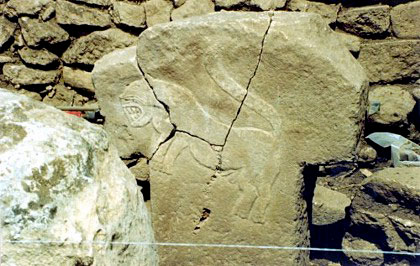
T-shaped stelae discovered during excavations are believed to have
religious significance. The carvings on these stelae are the earliest
examples of Neolithic art.
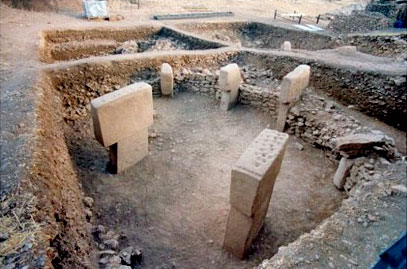
Scientists are rushing to see the 11,500 year-old remains of temples
discovered during excavations in Göbeklitepe.
Upper Mesopotamia
(SE Turkey, N Syria and N Iraq) 14C databases:
11th - 6th millennia cal BC
III. Gaziantep-Urfa-Mardin plateau
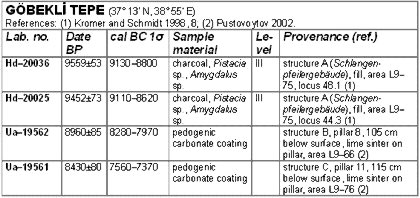
Comment GÖBEKLI TEPE
The Schlangenpfeilergebäude pertains to the earlier of the two
building phases attested thus far at the site, i.e. Old Phase (level
III) and Young Phase (level II) (where level I relates to the
topsoil finds). Since coming from the fill of the structure, the two
level III samples may postdate the Old Phase.
The two dates yielded
by pedogenic carbonate coatings of pillars 8 and 11 from structures
B and C resp. constitute an terminus ante quem for these buildings.
At the time suggested by these two dates, both structures had
already been abandoned and buried.
|







